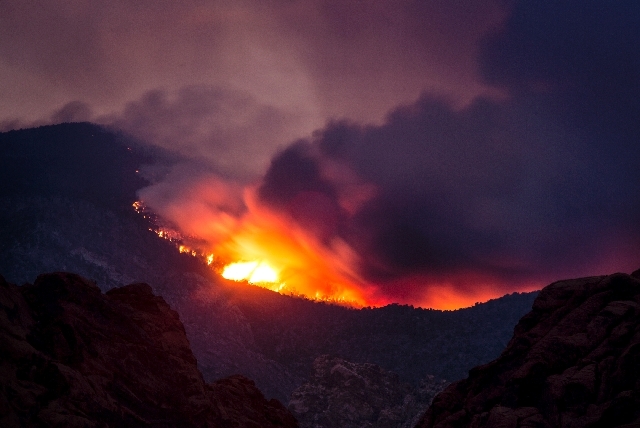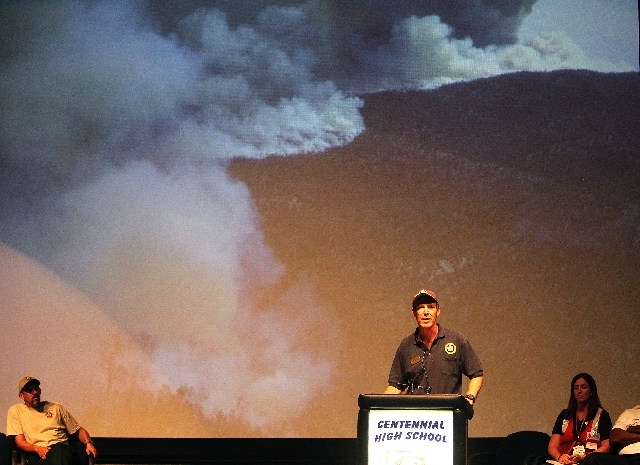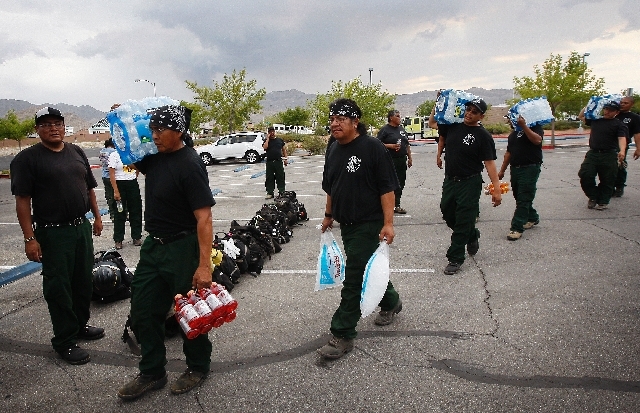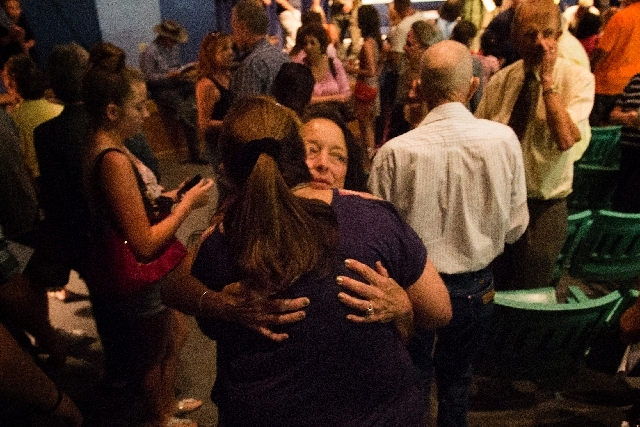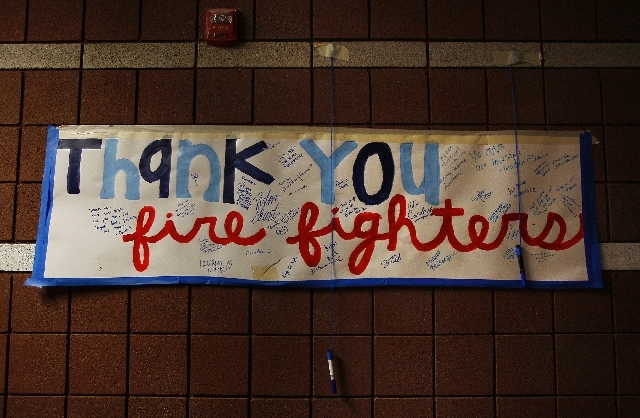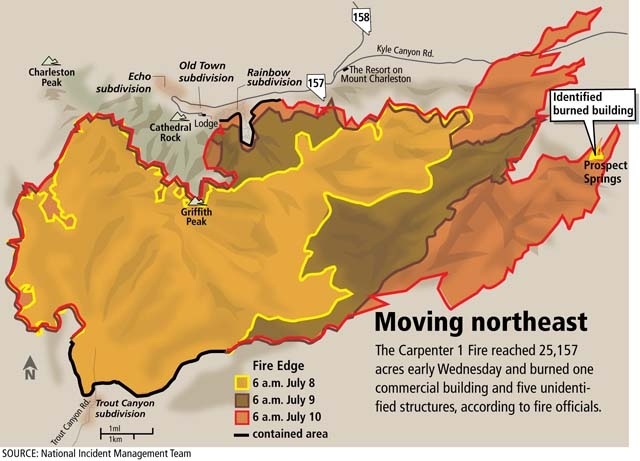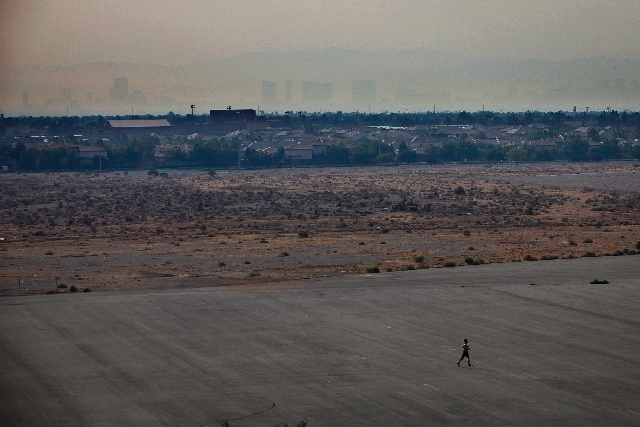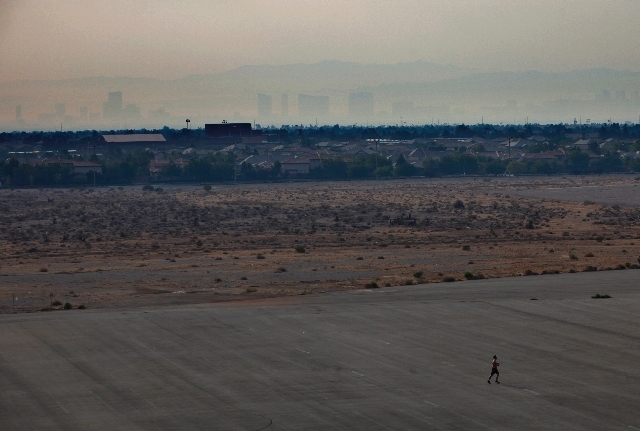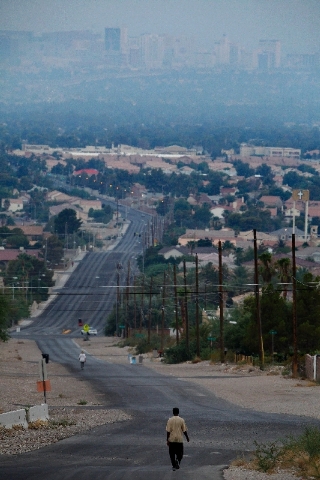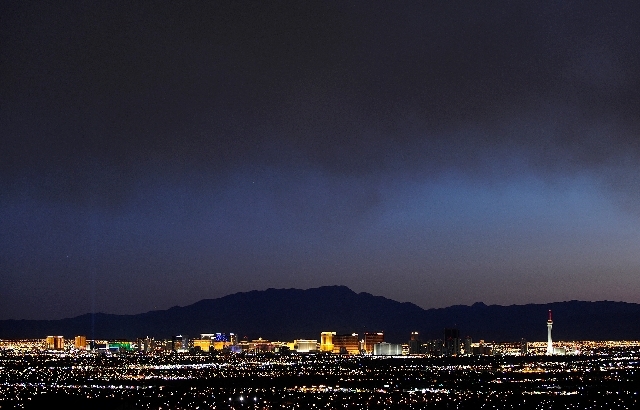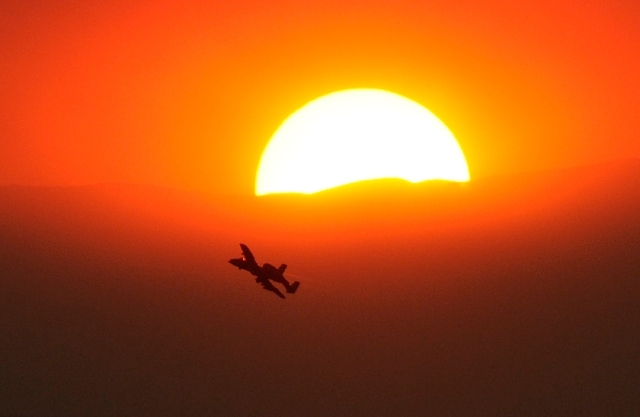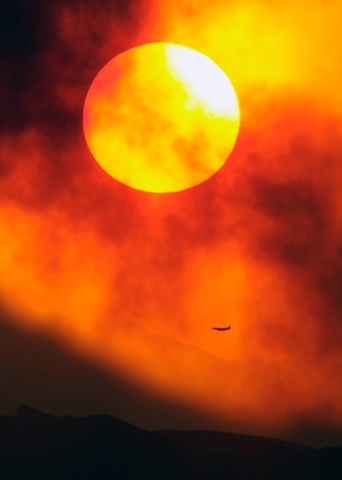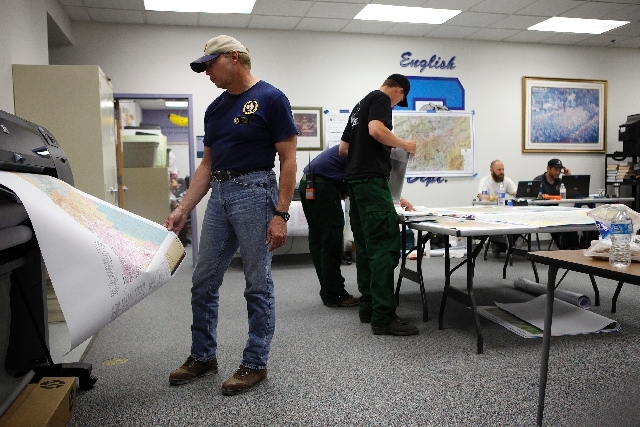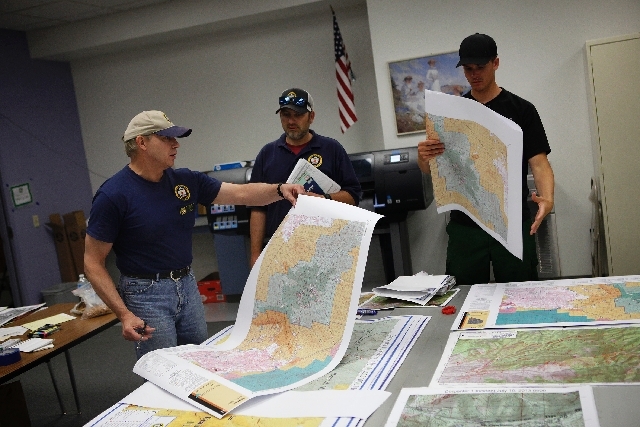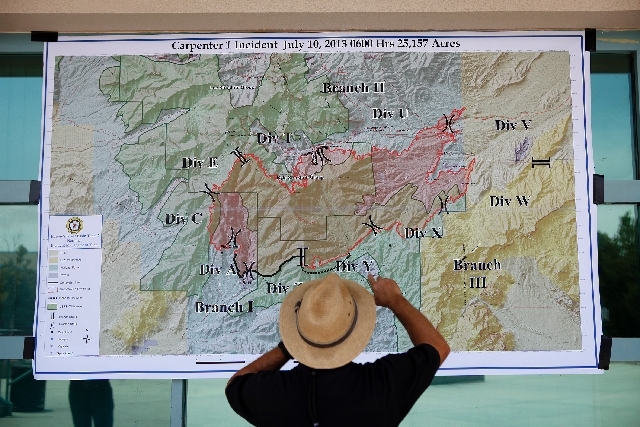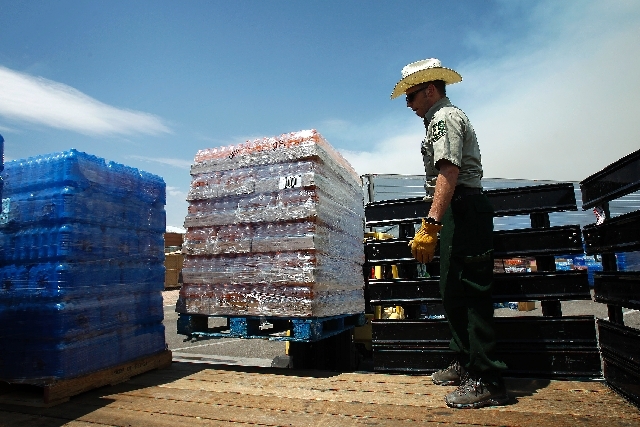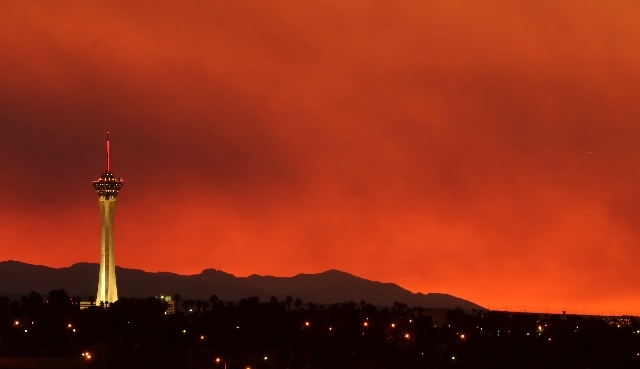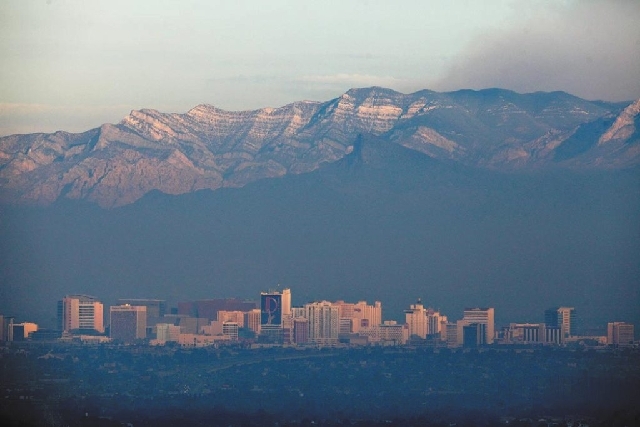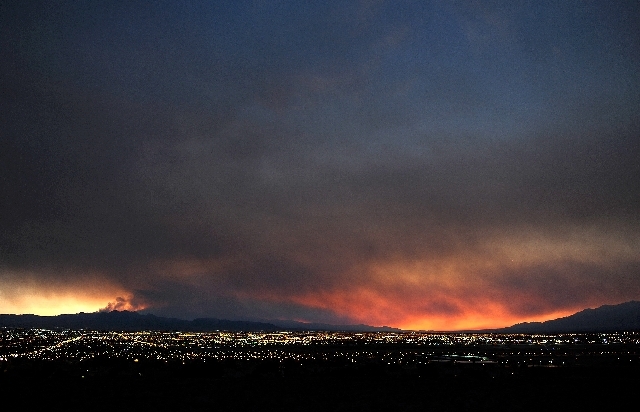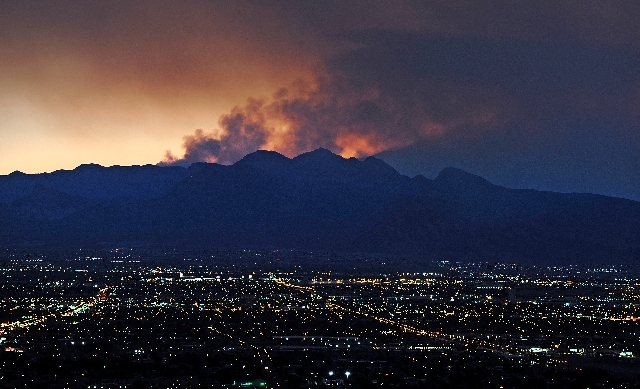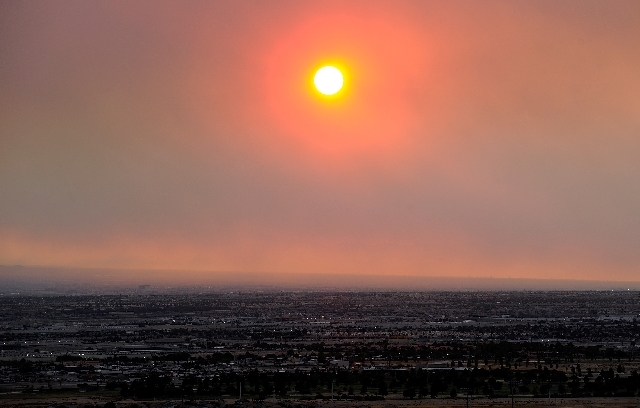25,000-acre fire in ‘backyard’ of Resort on Mount Charleston; 2 firefighters injured
They’ve turned a dormant high school into an active war room, deploying firefighting units and planning their next attack on the enemy.
They are the commanders coordinating the battle against the blaze that has scorched more than 40 square miles of the Spring Mountains since July 1. On Wednesday, the wildfire spread to remote areas of the Red Rock Canyon National Conservation Area.
You won’t see any smoky images of the strategists covered in soot and ash. They’re not in the mountains fighting the fire with shovels and axes.
Rich Harvey’s Great Basin Incident Management Team 2 is battling the 27,597-acre Carpenter 1 Fire from Centennial High School, using infrared maps, detailed meteorological outlooks, a flood of data and every other tool at its disposal.
The management team must attack the fire like a well-trained military, positioning and commanding the forces from a central command post.
“It’s less reliable than a war zone,” team spokeswoman Madonna Lengrich said Wednesday. “At least you know what sides the bullets are coming from in a war zone.”
The fire had consumed six structures in the Prospect Springs area as of Wednesday evening. Two firefighters suffered ankle injuries on the mountain Wednesday, with one having to be flown out by helicopter because of the tough, rocky terrain where he was located.
Operations Section Chief Rod Collins pored over the 4-foot map detailing the fire line and location of each division as he briefed two recently arrived firefighters in what used to be a classroom.
“This place is a tinderbox,” he told them, remarking on the unusually dry fuels that, along with what he calls “squirrely winds,” have helped push the flames down much of Kyle Canyon.
Collins went over the map, inch by inch, describing to the two young, bearded firefighters the terrain, the protected areas, the endangered species at risk — such as the desert tortoise, which has a tendency to wander underneath the large fire rigs — and a plethora of other details about the fire zone.
“That’s a lot of info,” one said as he studied the terrain he was headed into.
SNUFFING OUT THE ‘SLOPOVER’
Flames on Tuesday crossed state Route 157, the road that runs through Kyle Canyon. By Wednesday, crews had snuffed out what Harvey referred to as the 300-acre “slopover” thanks to a flatter, more easily attacked terrain.
Harvey announced Wednesday evening that the fire, which started July 1 after a lightning strike just south of Carpenter Canyon, was 15 percent contained. He noted that firefighters were considering the area around Rainbow subdivision, where flames came within feet of some structures, contained.
Information is the weapon of choice for Harvey’s Great Basin Incident Management Team 2. All members of the team — more than 1,000 fire personnel, from the Type I Hot Shot back-burning in the middle of the night near Rainbow subdivision to Situation Unit Leader Tom Dunn, who oversees much of the infrared maps — work off the same daily plan, maps and schedule.
“It’s one common operating picture,” Dunn said.
The goal is to keep the firefighters on the lines safe by working off a singular plan, something Collins calls the “unity of command.”
“Everybody’s gotta know the plan,” said Collins, who hails from Lake Tahoe.
It’s more than just knowing the plan. Collins and Operations Section Chief Brad Washa keep track of exactly where individual units are at any time.
Are the members of the Division Tango sleeping in a spike camp on the line? Are they coming back to the incident command post for a hot meal? They have to keep track of every member of every unit, otherwise people get hurt, or worse, Collins said.
“Our No. 1 mission is the safety of the public and emergency responders,” he said.
They have the services of the individual crews for only a finite amount of time. Each crew can work 14 straight 16-hour days before the firefighters are required to go home for two days.
Members of Harvey’s team are constantly tracking the size and location of the fire, in conjunction with the allotted amount of time they have with each fire crew, to decide when they need to put the order in for more firefighters.
The firefighting effort continues to grow and now includes 12 Hot Shot crews, 44 fire engines, 13 helicopters, 10 water trucks and two dozers. On Tuesday, the helicopters dropped 162,000 gallons of water and spent 56 hours combined flying time.
“People are naturally afraid of smoke,” Fire Information Officer John Kohn said. “It’s an instinct. But we’re not losing the battle.”
PROTECTING THE PINE TREES
Harvey told residents during the nightly community meeting Wednesday that they shouldn’t expect to see scorched land around their homes. There is some green remaining, and the Ponderosa pines were mostly holding their own against the flames, he said.
Residents also were told that Las Vegas police will no longer escort evacuees back to their Mount Charleston homes to pick up their belongings.
One woman shouted out her appreciation to the firefighters during the meeting to resounding applause.
“They’re going to do what they have to do,” Harvey said of the firefighters. “We’re in the fight to the finish.”
On Wednesday, Clark County issued the highest alert possible for air quality because of the smoke. The alert, in effect through today, urges people to stay indoors and use air conditioning, which filters particles from the air.
Firefighters, who have been battling extreme heat and low humidity, are expected to receive some cooler weather starting today.
The National Weather Service has issued a flash flood watch for the Mount Charleston area, lasting from 8 a.m. today to 5 a.m. Friday.
The Carpenter 1 Fire has cost more than $9.4 million to date. The Federal Emergency Management Agency on Monday authorized the use of federal funds to assist with fire combat. FEMA will reimburse agencies for 75 percent of the eligible firefighting costs.
MEETING LOCATION CHANGES
Late Wednesday, Harvey announced on Twitter that the daily 5:30 p.m. meetings to update the public on the status of the fire will be held at the Red Rock Canyon National Conservation Area visitors center at 1000 Scenic Loop Drive.
Monetary donations can be made to the National Wildland Firefighter Foundation by calling 208-336-2996 or visiting www.wffoundation.org. The American Red Cross is accepting donations by phone at 702-369-3674 or online at www.redcross.org/lasvegasfirehurts.
Agencies involved with fighting the fire as well as offering support include the U.S. Forest Service, Bureau of Land Management, Nevada Division of Forestry, Metropolitan Police Department, NV Energy, The American Red Cross, Pahrump Valley Fire Department, Clark County Fire Department, Nevada Highway Patrol, Nevada Department of Emergency Management and Bureau of Indian Affairs.
Review-Journal writer Steve Tetreault contributed to this report. Contact Steven Slivka at SSlivka@reviewjournal.
com or 702-383-0264. Contact reporter Colton Lochhead at CLochhead@reviewjournal.com or 702-383-4638. Follow him on twitter @clochhead44. Contact reporter Rochel Leah Goldblatt at
rgoldblatt@reviewjournal.com or 702-383-0264.

RELATED STORY:
Been there, extinguished that, bought the T-shirt
FIRE INFORMATION
702-799-4610
inciweb.org
Related stories
• Fire within sight of Kyle Canyon homes
• Winds keeping damaging wildfire smoke away from Las Vegas



